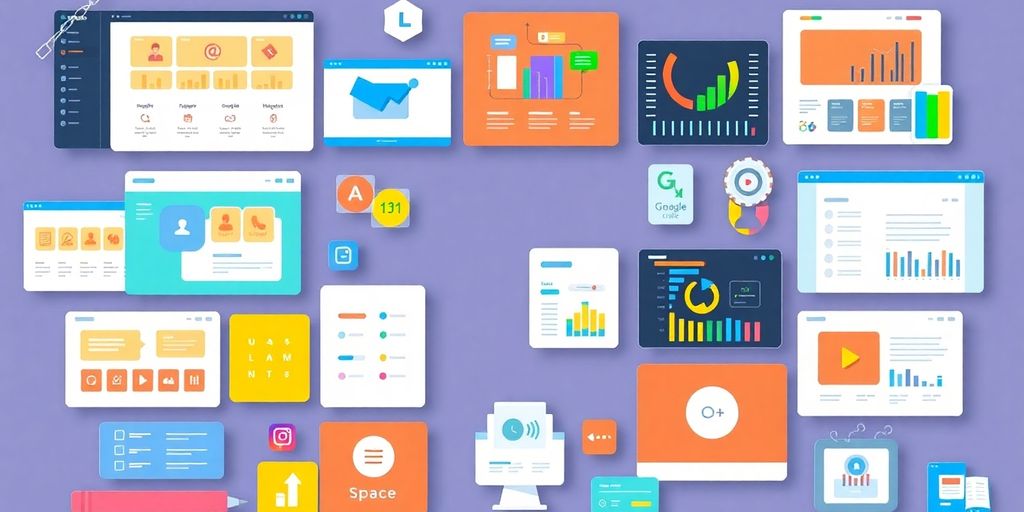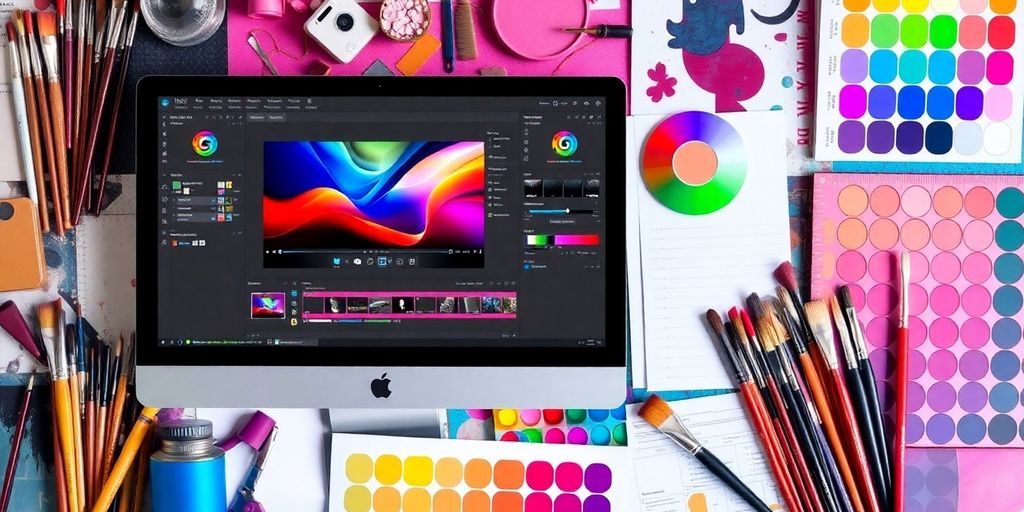Language Learning Apps Alternatives: Immersive & Free Resources

Learning a new language can feel overwhelming, especially with so many options out there. While language learning apps are popular, there are plenty of free resources that can help you immerse yourself in a new language without spending a dime. From websites to community exchanges, multimedia tools, and even social media, there are various alternatives that can enhance your language learning experience. In this article, we’ll explore different ways to learn a language for free and share some tips on how to make the most of these resources.
Key Takeaways
- There are many free websites that offer structured language courses and interactive lessons.
- Language exchange communities can help you practice speaking with native speakers.
- Using movies, podcasts, and audiobooks can make learning more enjoyable and effective.
- Audio-focused techniques can improve your listening skills and pronunciation.
- Social media platforms can provide engaging ways to practice and connect with other learners.
Exploring Free Language Learning Websites
Benefits of Free Resources
Let’s be real, learning a new language can get expensive fast. That’s where free resources come in clutch. The biggest perk? Zero cost! You can start learning without dropping a dime. This is awesome if you’re just testing the waters with a language or don’t have a huge budget. Plus, free resources are usually super accessible. You can find them on your phone, computer, or tablet, making it easy to squeeze in some learning time whenever you have a few spare minutes. They also let you try out different methods to see what clicks for you without any commitment.
Popular Free Language Learning Websites
Okay, so where do you actually go to learn a language for free? There are tons of options, but here are a few popular ones:
- Duolingo: This is probably the most well-known. It’s gamified, making it feel more like a game than studying. You can learn a bunch of different languages, and it’s great for building a basic vocabulary.
- Memrise: Memrise is all about memorization. It uses flashcards and spaced repetition to help you remember words and phrases. It’s especially good for vocabulary.
- YouTube: Don’t sleep on YouTube! There are tons of channels dedicated to language learning. You can find lessons on grammar, pronunciation, and even cultural insights. Just search for the language you want to learn, and you’ll find a ton of content.
- Open Culture: This site aggregates a bunch of free language learning resources from around the web. You can find free courses, audio lessons, and e-books.
Free resources are a great way to start learning a language, but they might not be enough to get you to fluency. Consider supplementing them with other resources, like language exchange partners or paid courses, if you’re serious about mastering the language.
How to Maximize Your Learning Experience
Alright, you’ve found some free resources, now what? Here’s how to make the most of them:
- Set realistic goals: Don’t try to learn everything at once. Start with small, achievable goals, like learning a few new words each day or completing one lesson per week.
- Be consistent: The key to language learning is consistency. Try to dedicate some time to learning every day, even if it’s just for 15-20 minutes.
- Find a learning style that works for you: Some people learn best by reading, while others prefer listening or speaking. Experiment with different methods to see what works best for you.
- Don’t be afraid to make mistakes: Everyone makes mistakes when they’re learning a new language. The important thing is to learn from them and keep practicing.
- Supplement with other resources: Free resources are great, but they might not cover everything. Consider supplementing them with other resources, like language exchange partners, paid courses, or even just watching movies and TV shows in your target language.
Engaging with Language Exchange Communities

Language learning doesn’t have to be a solitary activity. Connecting with others who are also learning, or who are native speakers, can seriously boost your progress. It’s about finding ways to practice what you’re learning in a real-world context, and language exchange communities are perfect for that.
Finding Language Partners
So, where do you find these language partners? There are a bunch of online platforms designed specifically for language exchange. Think of apps and websites like Tandem or HelloTalk. These connect you with native speakers who are learning your native language. It’s a win-win! You help them, they help you. Also, don’t underestimate the power of local communities. Check out local language meetups or conversation groups. Sometimes, the best partners are right in your own city.
Benefits of Language Exchange
The biggest benefit is practical application. You’re not just memorizing vocabulary; you’re actually using it in conversations. This helps with fluency, pronunciation, and understanding natural speech patterns. Plus, you get immediate feedback. Native speakers can correct your mistakes and offer tips that textbooks often miss. It’s also a great way to learn about the culture associated with the language. You’ll pick up slang, idioms, and cultural references that make the language come alive.
Tips for Effective Language Exchange
Okay, so you’ve found a partner. Now what? Here are a few tips to make the most of it:
- Set clear goals. What do you want to achieve in each session? Focus on specific topics or skills.
- Be patient and supportive. Everyone makes mistakes. Create a comfortable environment where you both feel free to experiment.
- Prepare in advance. Have some conversation starters or topics ready to go. This avoids awkward silences and keeps the conversation flowing.
- Use a mix of languages. Spend equal time speaking in both languages to ensure a fair exchange.
- Don’t be afraid to ask questions. If you don’t understand something, ask for clarification. That’s what you’re there for!
Language exchange is more than just practicing grammar. It’s about building connections, understanding different perspectives, and having fun while learning. It can be a really rewarding experience if you approach it with the right attitude.
Utilizing Multimedia for Language Learning
Learning Through Movies and TV Shows
Movies and TV shows are awesome for language learning. They provide context, culture, and natural speech patterns you won’t find in textbooks. It’s not just about memorizing words; it’s about understanding how people actually use the language. You can find content from a particular country or region if you’re trying to acclimate your ear to a certain dialect or accent. Platforms like AI translation for WordPress can help with subtitles and understanding.
- Start with subtitles in your native language, then switch to the target language.
- Pause and rewind often to catch unfamiliar words or phrases.
- Pay attention to body language and facial expressions for added context.
Watching movies in another language can be challenging at first, but it gets easier with practice. Don’t be afraid to start with something simple and work your way up to more complex material.
Podcasts and Audiobooks for Language Practice
If you’re the kind of person who enjoys podcasts and audiobooks, consider an audio-focused language learning program. Podcasts and audiobooks are great because you can listen to them anywhere – during your commute, while doing chores, or even at the gym. Immersion is key, and these resources make it easy to surround yourself with the language.
- Choose podcasts or audiobooks that match your skill level.
- Listen actively, taking notes on new vocabulary and grammar.
- Replay sections you find difficult to understand.
Interactive Videos and Subtitles
Interactive videos, especially those with dual-language subtitles, can really boost your learning. Some platforms let you click on words to see their definitions or even provide quizzes to test your comprehension. This active engagement makes the learning process more effective. Platforms like Yabla and Lingopie offer this, letting you watch videos with the option to show closed captioning in the native language as well as English subtitles.
- Look for videos with interactive transcripts or subtitles.
- Use the pause and rewind features to review difficult sections.
- Take advantage of any quizzes or exercises to test your understanding.
Audio-Focused Language Learning Techniques
Overview of Pimsleur and Michel Thomas
If you’re someone who enjoys podcasts or audiobooks, then audio-focused language learning might be perfect for you. Two popular options are Pimsleur and Michel Thomas. Both methods are named after their creators and were initially available as tapes and CDs. Now, they’ve transitioned into app formats, making them more accessible than ever.
Pimsleur lessons are primarily audio-based, with each lesson revolving around a 20-minute recording. The lessons break down conversations meticulously, using repetition to aid learning. While the audio quality is good and cultural information is included, some may find the experience tiring. Michel Thomas, on the other hand, uses a different approach, focusing on building a foundation by understanding the core structures of the language. The instructor guides you through building sentences, encouraging active participation. Mondly also uses auditory aids to accommodate your learning style. The instructor speaks the words and phrases in a melodic way, which makes it easier to recall them.
Benefits of Audio Learning
Audio learning offers several advantages. First, it’s incredibly convenient. You can listen while commuting, exercising, or doing chores. This makes it easy to integrate language learning into your daily routine. Second, it helps improve your listening comprehension and pronunciation. By hearing native speakers, you become more attuned to the nuances of the language. Third, audio learning can be less intimidating than other methods. You don’t have to worry about visual cues or grammar rules initially; you can simply focus on understanding and repeating what you hear.
Audio-based learning is great because it lets you learn on the go. It’s perfect for those who have busy schedules but still want to make progress in their language studies. Plus, it really helps with pronunciation and getting used to the rhythm of the language.
Best Practices for Listening Comprehension
To maximize the benefits of audio learning, here are a few best practices:
- Start with shorter lessons: Don’t overwhelm yourself. Begin with 10-15 minute sessions and gradually increase the duration as you become more comfortable.
- Listen actively: Pay attention to the pronunciation, intonation, and rhythm of the speakers. Try to mimic what you hear.
- Use transcripts: If available, use transcripts to follow along with the audio. This can help you understand difficult passages and identify new vocabulary.
- Repeat and review: Listen to the same lesson multiple times. Repetition is key to reinforcing what you’ve learned.
- Take notes: Jot down new words, phrases, or grammar points that you encounter. Review these notes regularly.
By following these tips, you can make the most of audio-focused language learning and improve your listening comprehension skills.
Incorporating Social Media into Language Learning
Social media isn’t just for keeping up with friends; it can be a surprisingly effective tool for language learning. The key is to be intentional about how you use these platforms. Instead of passively scrolling, think of social media as a way to immerse yourself in your target language and connect with other learners.
Using Instagram for Language Practice
Instagram, with its visual focus, can make language learning more engaging. Following accounts that post in your target language is a great way to expose yourself to new vocabulary and cultural insights. You can find everything from language learning accounts that offer quick tips to news outlets and celebrity pages that provide real-world language exposure. Pay attention to captions, stories, and comments to see how people actually use the language. Instagram’s format makes language learning enjoyable and accessible.
Engaging with Language Learning Groups
Facebook groups, Reddit communities, and other online forums dedicated to language learning can provide a supportive environment for practice and motivation. These groups often host challenges, share resources, and offer feedback on your writing or speaking. Don’t be afraid to participate, even if you’re a beginner. Asking questions and interacting with other learners can boost your confidence and help you learn from others’ mistakes. It’s a great way to find language partners.
Creating Content in Your Target Language
One of the best ways to solidify your language skills is to start creating your own content. This could be anything from writing short posts on Twitter to creating videos for YouTube or TikTok. The act of producing language forces you to think actively about grammar, vocabulary, and sentence structure. Plus, sharing your content can connect you with native speakers who can offer feedback and encouragement.
Creating content in your target language is a great way to improve. It forces you to actively use what you’ve learned, and it can be a fun way to track your progress over time. Don’t worry about making mistakes; that’s part of the learning process.
Leveraging Online Tutoring Platforms
Online tutoring platforms have changed how we learn languages. Instead of relying solely on apps or textbooks, you can now connect with native speakers and experienced tutors from around the globe. It’s like having a personalized language coach available whenever you need them.
Benefits of One-on-One Tutoring
One of the biggest advantages of online tutoring is the personalized attention you receive. Tutors can tailor lessons to your specific needs and learning style, something that’s hard to achieve with a generic app. You get immediate feedback on your pronunciation and grammar, helping you correct mistakes in real-time. Plus, it’s a great way to build confidence in speaking. Here are some key benefits:
- Personalized learning plans
- Immediate feedback and correction
- Flexible scheduling
- Cultural insights from native speakers
Popular Online Tutoring Services
There are many online tutoring platforms to choose from, each with its own strengths. Some popular options include italki, Verbling, and Preply. Italki offers a wide range of tutors at different price points, while Verbling focuses on providing certified teachers. Preply uses AI to match you with the best tutor based on your goals and learning style. Don’t forget to check out Langua AI platform for an alternative approach to language learning.
How to Choose the Right Tutor
Choosing the right tutor can make or break your online learning experience. Start by defining your goals: what do you want to achieve? Are you preparing for a test, or do you simply want to improve your conversational skills? Read reviews and watch introductory videos to get a sense of the tutor’s teaching style. Consider their experience, qualifications, and whether they specialize in the areas you want to focus on. Finally, don’t be afraid to try a few different tutors before settling on one that’s a good fit.
Finding the right tutor is a bit like dating. You might have to go on a few "first dates" before you find someone you really click with. Don’t get discouraged if the first tutor isn’t perfect. Keep trying until you find someone who understands your needs and motivates you to learn.
Exploring Niche Language Learning Resources

Sometimes, the big-name apps just don’t cut it. Maybe you’re learning a less common language, or perhaps you have very specific learning needs. That’s where niche resources come in handy. They can be a game-changer for focused learning.
Resources for Less Common Languages
Finding resources for languages like Navajo, Icelandic, or Swahili can be tough. Mainstream apps often focus on the most popular languages, leaving learners of less common tongues in the dust. Luckily, there are specialized websites and communities dedicated to these languages. These resources often include native speaker content, detailed grammar explanations, and cultural insights you won’t find anywhere else. For example, you might find a dedicated website for learning Basque grammar or an online dictionary specifically for Gaelic.
Specialized Apps for Unique Needs
Not everyone learns the same way. Some people need apps that focus on pronunciation, while others want to improve their reading comprehension. There are apps designed for specific learning styles or needs. For instance, if you’re a visual learner, you might benefit from an app that uses flashcards and images. If you struggle with grammar, look for an app that provides detailed explanations and practice exercises. Finding the right fit can make a huge difference.
Community Forums for Niche Languages
Online forums and communities can be invaluable resources for language learners. They provide a space to connect with other learners, ask questions, and share resources. These forums often have sections dedicated to specific languages or learning challenges. You can find native speakers willing to help you practice, or other learners who can share their experiences and tips. It’s a great way to boost your studies and stay motivated.
Language learning is a personal journey, and what works for one person may not work for another. Don’t be afraid to experiment with different resources and find what suits your needs and learning style best. The key is to stay curious, persistent, and engaged in the process.
Wrapping It Up: Free Language Learning Resources
So, there you have it. If you’re looking to learn a new language without breaking the bank, there are plenty of free resources out there. From apps like Duolingo and Memrise to websites like Lingopie, you can find something that fits your style. Whether you’re just starting or trying to polish your skills, these tools can really help. Plus, they make learning fun and engaging. So why not give them a shot? You might just find that learning a new language is easier and more enjoyable than you thought. Dive in and start exploring the world of languages today!
Frequently Asked Questions
What are some good free websites to learn a new language?
There are many great free websites for language learning, like Duolingo, Memrise, and BBC Languages. These sites offer fun lessons and exercises to help you learn.
Can I really learn a language using only free resources?
Yes! You can learn a language for free using various websites and apps. They provide lessons, exercises, and even games to make learning enjoyable.
What is the best way to practice speaking a new language?
The best way to practice speaking is by finding a language partner or joining language exchange groups online. You can also use apps that connect you with native speakers.
Are there any apps that focus on listening skills?
Yes! Apps like Pimsleur and Michel Thomas focus on audio learning, which can help improve your listening and speaking skills.
How can I use social media to help with language learning?
You can follow accounts that post in the language you’re learning, join language learning groups, and even create your own posts in that language to practice.
What should I look for in an online tutor?
When choosing an online tutor, look for someone who has experience teaching your target language, offers flexible scheduling, and matches your learning style.








Responses